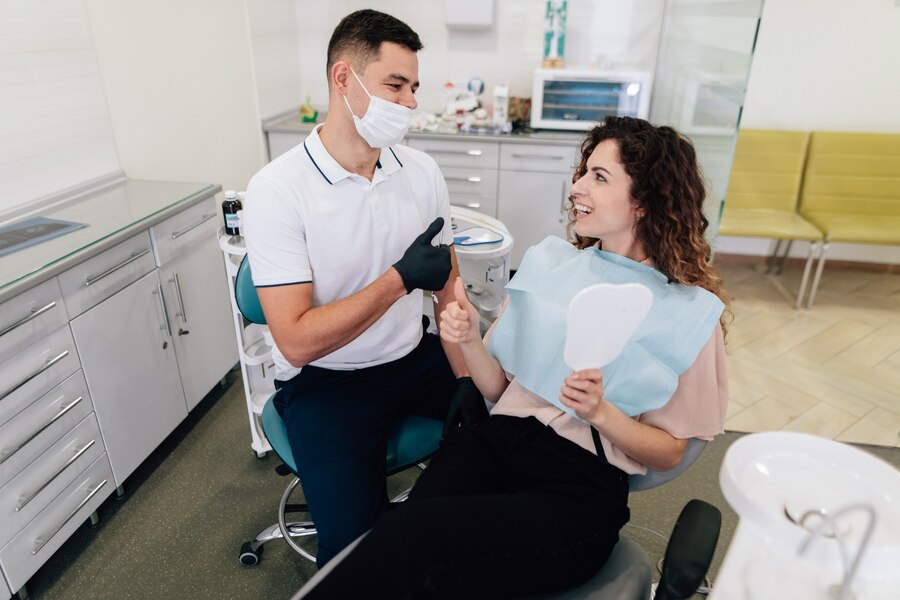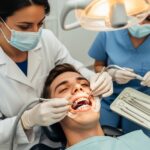When people think of orthodontists, braces often come to mind. However, orthodontists do much more than just fit metal brackets on teeth. They specialize in diagnosing, preventing, and treating dental and facial irregularities. In this article, we’ll explore the diverse range of treatments that orthodontists offer beyond braces, from aligners and retainers to surgical options. If you’ve ever wondered what else an orthodontist does, you’re in the right place.
The Role of an Orthodontist: More Than Just Braces
Orthodontists focus on improving oral health and the functionality of teeth and jaws. While braces are the most well-known treatment, orthodontists have a wide array of tools and techniques to help patients achieve a healthy smile. Understanding these options can make a huge difference in your dental health journey.

1. Clear Aligners: The Modern Alternative to Braces
One of the most popular alternatives to traditional braces is clear aligners. These transparent, removable trays are custom-made to fit your teeth and gradually move them into the desired position. Unlike braces, they offer a discreet way to straighten teeth without metal wires or brackets.
Clear aligners are especially popular among adults and teenagers who want a more aesthetic solution to correct their smiles. They require discipline since they must be worn for at least 20-22 hours a day for optimal results. The orthodontist typically creates a new set of aligners every few weeks to continue guiding the teeth into proper alignment.
2. Retainers: Maintaining That Perfect Smile
Once you’ve gone through the process of braces or clear aligners, the next step usually involves a retainer. Retainers help keep your teeth in their new positions and prevent them from shifting back to their original alignment. They come in two main types: fixed and removable.
- Fixed Retainers: These are usually bonded to the back of your teeth and stay in place for several years. Fixed retainers are a great way to ensure that your teeth remain aligned without any effort on your part.
- Removable Retainers: These are made of clear plastic and can be taken out when eating or brushing your teeth. Removable retainers are convenient and easy to clean, but they require more diligence to wear consistently.
3. Space Maintainers: Guiding Growing Teeth
For children, orthodontists often use space maintainers to ensure that adult teeth grow in properly. When a child loses a baby tooth prematurely, the surrounding teeth can shift into the empty space, leading to issues with the alignment of the new tooth. A space maintainer holds the space open, allowing the permanent tooth to emerge correctly.
Space maintainers are a preventive tool that reduces the need for more extensive orthodontic treatment later in life. They can be either fixed or removable, depending on the individual needs of the patient.
4. Orthodontic Appliances for Jaw Correction
Orthodontists also use various appliances to address jaw-related issues like overbites, underbites, and crossbites. These problems often require a combination of dental devices that gradually adjust the jaw’s position.
- Palatal Expanders: These devices are used to widen the upper jaw, allowing for better alignment of the upper and lower teeth. Palatal expanders are often recommended for younger patients whose jaws are still developing.
- Headgear: Although not as common as it used to be, headgear can still be effective in guiding jaw growth and correcting severe bite issues. It applies gentle pressure to the teeth and jaw to improve their alignment.
5. Surgical Orthodontics: Advanced Treatment for Severe Cases
In cases where misalignment is severe and cannot be corrected with braces or other orthodontic devices, surgical orthodontics may be necessary. This type of surgery focuses on correcting abnormalities in the jawbone structure that affect the bite and facial symmetry.
Surgical orthodontics is usually performed in conjunction with other orthodontic treatments, like braces or aligners, to achieve the best possible outcome. The orthodontist works closely with an oral surgeon to ensure that the procedure aligns the jaw correctly.
Beyond Straightening: Orthodontists’ Role in Facial Symmetry and Aesthetics
An orthodontist’s work goes beyond just straightening teeth. They play a crucial role in enhancing facial symmetry and aesthetics. The position of your teeth and jaws can significantly impact the appearance of your face. Orthodontic treatments can improve your smile, enhance your facial profile, and even contribute to better speech and chewing functionality.
Orthodontists often collaborate with cosmetic dentists and other specialists to develop comprehensive treatment plans that address both functional and aesthetic concerns. This multidisciplinary approach ensures that patients receive holistic care tailored to their unique needs.
The Psychological Impact of Orthodontic Treatment
The benefits of orthodontic care extend beyond physical health. Improved self-esteem and confidence are common psychological outcomes for patients undergoing orthodontic treatment. A well-aligned smile can enhance social interactions, increase self-assurance, and positively influence one’s professional and personal life.
For teenagers and adults alike, having a smile they feel proud of can lead to a significant boost in overall well-being and mental health. It’s not just about aesthetics; it’s about how you feel when you present yourself to the world.
6. Preventive Orthodontics: Interceptive Treatments for Children
Preventive orthodontics focuses on identifying and addressing potential dental issues before they become significant problems. For children, early detection of misalignment or jaw growth issues allows the orthodontist to intervene with interceptive treatments that can guide proper dental development.
Techniques like space maintainers, palatal expanders, and partial braces may be used to prevent more serious issues from developing as the child grows. The goal is to minimize or eliminate the need for extensive orthodontic work in the future.
How Orthodontists Work with Other Dental Professionals
Orthodontists frequently collaborate with other dental specialists to provide comprehensive care. This team approach ensures that all aspects of a patient’s oral health are addressed. Whether it’s a pediatric dentist managing early childhood dental concerns or an oral surgeon handling complex jaw issues, an orthodontist’s role is integral to the overall treatment plan.
Working together with general dentists, cosmetic dentists, periodontists, and other specialists, orthodontists ensure that every patient receives customized care tailored to their specific needs. This multidisciplinary strategy enhances the patient’s experience and optimizes treatment outcomes.
7. Managing TMJ Disorders: Relief from Jaw Pain
Orthodontists also play a significant role in diagnosing and treating temporomandibular joint (TMJ) disorders. These conditions can cause jaw pain, headaches, and difficulty in chewing. By realigning the bite and adjusting the position of the jaw, orthodontic treatment can alleviate the discomfort associated with TMJ disorders.
Splints, night guards, and braces are among the common treatments used to address TMJ issues. The aim is to reduce stress on the joint and improve jaw function, providing patients with long-term relief.
8. Treating Sleep Apnea with Orthodontic Solutions
Sleep apnea is a condition characterized by interrupted breathing during sleep. In some cases, the positioning of the jaw and tongue plays a significant role in obstructing the airway. Orthodontists can offer solutions such as oral appliances that reposition the jaw to keep the airway open during sleep.
These custom-made devices are similar to mouthguards and help patients maintain regular breathing patterns throughout the night. Orthodontic treatment for sleep apnea not only improves sleep quality but also reduces the risk of associated health complications.
9. Early Orthodontic Evaluation: Why Timing Matters
One of the most critical aspects of orthodontic care is early evaluation. The American Association of Orthodontists (AAO) recommends that children have their first orthodontic check-up by the age of seven. Early evaluation allows the orthodontist to detect potential problems with jaw growth, the alignment of teeth, and bite issues before they become more complex.
Early intervention can make a significant difference in the effectiveness and duration of treatment. By assessing the development of the teeth and jaw at an early age, orthodontists can create a proactive treatment plan that guides the growth of the jaw and the positioning of teeth. This approach often reduces the need for more intensive procedures later on, making the process smoother and more cost-effective for patients.

Benefits of Early Orthodontic Treatment
Early orthodontic treatment, also known as interceptive treatment, can help address several common issues, including:
- Crowded Teeth: When there isn’t enough space in the mouth for all the teeth, early intervention can help create space and guide teeth into better alignment.
- Protruding Teeth: Teeth that stick out can be at a higher risk of injury and may also impact a child’s self-confidence. Early orthodontic care can reposition these teeth, providing both functional and aesthetic benefits.
- Bite Problems: Overbites, underbites, and crossbites can all be detected and managed more effectively if they are addressed at a young age.
Early treatment doesn’t always mean that braces or other devices will be used immediately. Instead, it means that the orthodontist will monitor growth and intervene at the right time to ensure the best possible outcome.
10. Orthodontic Treatment for Adults: It’s Never Too Late
Orthodontic treatment isn’t just for kids and teenagers. A growing number of adults are seeking orthodontic care to improve their smile and dental health. Advances in orthodontic technology, such as clear aligners and less visible braces, have made it more appealing and convenient for adults to undergo treatment.
For adults, the main goals of orthodontic treatment often include:
- Improving Dental Function: Properly aligned teeth make it easier to chew, speak, and maintain good oral hygiene.
- Enhancing Aesthetic Appearance: Adults frequently seek orthodontic care to boost their confidence and improve the overall look of their smile.
- Reducing the Risk of Dental Problems: Misaligned teeth can lead to a higher risk of cavities, gum disease, and tooth wear. By correcting these issues, orthodontic treatment can help preserve long-term oral health.
Orthodontists offer a variety of treatments tailored specifically for adults. With solutions like clear aligners and ceramic braces that blend with natural teeth, adults can discreetly undergo treatment without drawing attention to their dental work.
11. Lingual Braces: Hidden Solution for a Beautiful Smile
Lingual braces are another innovative option for those looking to straighten their teeth without the noticeable appearance of traditional braces. These braces are attached to the back of the teeth (the lingual side), making them virtually invisible when you smile.
Lingual braces offer all the effectiveness of traditional braces while remaining hidden from view. They are an excellent choice for individuals who want the benefits of braces but need to maintain a professional or polished appearance, such as in a work setting.
Although lingual braces are effective, they require precise adjustments and are typically more complex than standard braces. Orthodontists who specialize in this technique have advanced training to ensure that the braces deliver the desired results while maintaining comfort.
12. The Importance of Regular Orthodontic Check-ups
Routine check-ups are a vital component of orthodontic treatment. Even if you aren’t currently undergoing active treatment like braces or aligners, regular visits to the orthodontist can help identify potential issues before they escalate.
During these appointments, the orthodontist will:
- Monitor Tooth Movement: For patients with braces or aligners, check-ups ensure that the teeth are moving according to the treatment plan.
- Assess Retainer Fit: For those wearing retainers, these visits help confirm that the retainer is working correctly to maintain the position of the teeth.
- Examine Jaw Health: The orthodontist checks the alignment of the jaw to prevent or address TMJ disorders or bite issues.
Regular orthodontic care plays a crucial role in long-term dental health, preventing minor issues from turning into major problems that require extensive treatment.
13. Digital Orthodontics: How Technology is Transforming Treatment
Modern orthodontics has significantly benefited from advances in technology. Digital orthodontics uses state-of-the-art imaging techniques, 3D modeling, and computer-assisted design to create precise treatment plans tailored to each patient’s unique needs.
Benefits of Digital Orthodontics
- Accuracy: Digital scans of the mouth and teeth are more accurate than traditional impressions, leading to better-fitting appliances and more predictable treatment outcomes.
- Visualization: Patients can see a virtual representation of their treatment plan, including the expected results, which helps them understand the process and set realistic expectations.
- Comfort: Digital tools make the process of creating orthodontic appliances like aligners faster and more comfortable for patients.
Orthodontists who use digital technology can offer a higher level of precision and customization, ensuring that each treatment is designed to meet the specific requirements of the patient.
14. Orthodontics for Special Cases: Cleft Lip and Palate
Orthodontists often work as part of a multidisciplinary team to treat patients with special conditions such as cleft lip and palate. These conditions require a combination of orthodontic treatment, surgery, and other dental care to achieve optimal function and aesthetics.
Treatment typically begins early in childhood and continues through various stages as the patient grows. Orthodontic care for these cases focuses on aligning the teeth, preparing the mouth for surgeries, and ensuring that the bite is functional and the smile is aesthetically pleasing.
The expertise of an orthodontist is crucial in these complex cases, as they coordinate with surgeons, speech therapists, and other specialists to provide comprehensive care.
15. The Role of Orthodontics in Sports Dentistry
Orthodontists also play a role in sports dentistry by creating custom mouthguards that protect the teeth and gums during physical activities. Mouthguards are essential for athletes of all ages, particularly those who wear braces or other orthodontic appliances.
Custom mouthguards are designed to fit the unique shape of the patient’s mouth, providing a higher level of protection compared to over-the-counter options. This level of protection is vital for preventing injuries that could lead to dental trauma or damage to orthodontic appliances.
16. Holistic Orthodontic Approaches: Integrating Overall Health
An emerging trend in orthodontics is the holistic approach, which considers the impact of dental health on the body as a whole. Orthodontists who practice holistic care focus not only on the alignment of teeth but also on the relationship between oral health, nutrition, breathing patterns, and overall well-being.
Holistic orthodontic treatments may involve techniques to improve airway function, enhance posture, and address issues that could lead to sleep apnea or other systemic health concerns. This approach aims to optimize the patient’s health beyond just achieving a beautiful smile.
Conclusion
Orthodontists offer a wide range of treatments that go far beyond braces. From clear aligners and retainers to jaw-correcting appliances and surgical interventions, their expertise is crucial for achieving optimal dental health and enhancing facial aesthetics. Orthodontists also focus on preventive care, collaborating with other dental professionals to deliver comprehensive treatment plans that meet each patient’s unique needs.
If you’re seeking high-quality orthodontic care, look beyond just braces and consider the full spectrum of services available to you. Explore how treatments like aligners, jaw correction, and preventive orthodontics can transform your smile and boost your confidence.
For those interested in personalized orthodontic care, we recommend contacting Trinity Orthodontist. Their team of experts is dedicated to providing tailored treatments that suit your specific needs. Discover how their innovative solutions can help you achieve the smile you’ve always wanted.



